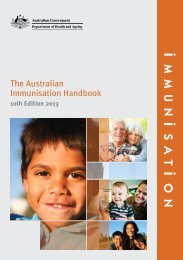Contents Chapter Topic Page Neonatology Respiratory Cardiology
Contents Chapter Topic Page Neonatology Respiratory Cardiology
Contents Chapter Topic Page Neonatology Respiratory Cardiology
Create successful ePaper yourself
Turn your PDF publications into a flip-book with our unique Google optimized e-Paper software.
NEONATAL JAUNDICE<br />
What is jaundice?<br />
Jaundice is apparent clinically when the level of bilirubin in the serum rises above<br />
85µmol/l (5mg/dl). Physiological jaundice is a reflection of the bilirubin load to the liver,<br />
rate of hepatic excretion (liver maturity) and ability of the serum binding protein to retain<br />
the bilirubin within the plasma.<br />
What can go wrong in jaundice?<br />
Elevated serum bilirubin can result in kernicterus, when unconjugated bilirubin is<br />
deposited in the cell wall of neurons in basal ganglia, brain stem and cerebellum<br />
resulting in cell death. Kernicterus is associated with a high mortality, and survivors<br />
usually suffer sequelae like athetoid cerebral palsy, high frequency hearing loss,<br />
paralysis of upward gaze and dental dysplasia. The factors influencing bilirubin toxicity<br />
in the brain cells of the neonate are complex and incompletely understood. There is no<br />
specific level of total serum bilirubin above which kernicterus can be predicted to<br />
happen.<br />
Causes of neonatal jaundice (NNJ)<br />
The following are the recognised causes of NNJ:<br />
• Haemolysis due to ABO or Rh isoimmunisation, G6PD deficiency,<br />
microspherocytosis, drugs<br />
• Physiological jaundice & idiopathic jaundice<br />
• Polycythaemia<br />
• Sepsis e.g. septicaemia, meningitis, urinary tract infection and intra-uterine<br />
infection<br />
• Breastfeeding and breastmilk jaundice<br />
Factors affecting severity of NNJ<br />
The following factors are said to affect the severity of jaundice<br />
• Dehydration<br />
• Large weight loss after birth<br />
• Extravasation of blood, cephalohaematoma, contusion<br />
• Swallowed maternal blood<br />
• Infant of diabetic mother<br />
• Acidosis<br />
• Asphyxia<br />
• Gastrointestinal tract obstruction: increase in enterohepatic circulation<br />
G6PD deficiency<br />
G6PD deficiency is an inherited disorder of the red blood cell, inherited in an x-linked<br />
recessive manner – males are affected while the females are carriers. G6PD is an<br />
enzyme essential in keeping glutathione in the reduced state that in turn is vital to<br />
maintain the integrity of the red cell membrane. In G6PD deficiency the red blood cells<br />
are prone to haemolysis when exposed to oxidants or when certain foods or herbs are<br />
ingested. A list of drugs and herbs that can precipitate haemolysis is provided in Table 1<br />
.
















